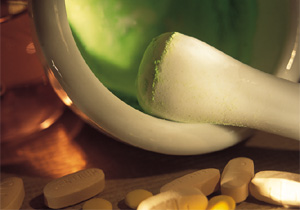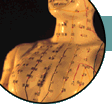Inquiring
Inquiring involves asking the patient or the patient's companion about
the disease condition to assist diagnosis.
Because the chief complaint of the patient is of primary importance,
the main information dealing with the problem must be carefully solicited. It is necessary to grasp the important clinical data as well as to get a general understanding of the patient's disease condition. The main categories of concern are:
Chills and Fever
Aversion to Cold and Fever : At the beginning of a disease, aversion
to cold and Fever occurs simultaneously. This indicates exterior
syndromes due to invasion by exogenous pathogenic factors.
The exterior syndromes due to invasion by exogenous pathogenic cold
and wind are characterized by severe aversion to cold, mild fever
accompanied by an absence of thirst, no sweat, headache, general pain,
superficial and tense pulse, etc.
The exterior syndromes due to invasion by exogenous pathogenic
wind-heat are characterized by severe fever, mild aversion to cold
accompanied by thirst, sweating, sore throat, superficial and rapid
pulse, etc.
Alternating Chills and Fever: This particular symptoms occurs when
exogenous pathogenic factors are in between the exterior and interior
of the body, accompanied by a bitter taste in the mouth, dry throat,
fullness of the chest, hypochondrium, etc. If a high fever follows
the first occurrence of chills and is complicated with a severe headache
which subsides after the fever is gone, this indicates malaria.
Fever Occurring without Chills
High fever: This is usually due to the transmission of exogenous
pathogenic cold from the exterior to the interior, which then changes
into heat; or the transmission of exogenous pathogenic heat from exterior
to interior resulting in shi type interior-heat syndrome accompanied by
profuse sweating, thirst, forceful pulse, etc.
Tidal fever: This is one of the main characteristics of yin
deficiency or shi heat syndrome of the Yangming channel. Tidal
fever due to yin deficiency often occurs at noon or night, accompanied
by a dry red tongue. Tidal fever usually appears at dusk associated
with constipation, abdominal distension, penis pain, etc.
Perspiration
Sweat is transformed from evaporated body fluid by the function of
yang qi. So perspiration has a certain clinical significance in
reflecting the status of yang qi and body fluid. On should first ask
whether the patient has sweat or not. If the patient is sweating,
further questioning should be concerned with the characteristics and
accompanied symptoms of perspiration.
Sweating of No Sweating: Exterior syndromes without sweating are
caused by exogenous pathogenic factors. Exterior syndromes with
sweating are mostly exterior heat syndromes due to the invasion by
exogenous pathogenic wind heat; or they may be exterior xu syndromes
due to exogenous pathogenic wind.
Night Sweating: Is usually the manifestation of yin deficiency,
accompanied by tidal fever, flushed malar, red tongue proper with
scanty coating, thready and rapid pulse.
Spontaneous Sweating: This is a sign of qi or yang deficiency
associated with fear of cold, lassitude, etc.
Profuse Sweating: Excessive sweating together with high fever,
thirst with desire for cold drinks, forceful pulse, etc. belong to
interior shi heat syndrome. This is the outcome of excessive yang
and heat compelling the outward flow of sweat. Dripping with sweat
accompanied by lassitude, feckless breathing, cold extremities, and
feeble pulse indicates the total prolapse of yang qi, also known as
"sweating from exhaustion."
Sweating of the Head: Caused by heat in the upper jiao or damp heat
in the middle jiao. It is caused by the heat in the upper jiao, it
will be accompanied by irritability, thirst, yellow tongue coating,
superficial and rapid pulse. if it is the result of damp heat
accumulation, it will be associated with heaviness and tiredness
of the body, dysuria, yellowish and sticky tongue coating, etc.
Appetite for Food and Drink, and Taste
No Appetite: This is a symptom caused by the dysfunction of transformation
and transportation of the spleen. Symptoms are emaciation due to chronic
disease, poor appetite, loose stool, lassitude, and pale tongue proper
with a thin white coating. If anorexia is associated with fullness of
the chest, abdominal distension, thick and sticky tongue coating, then
it is caused by the obstruction of pathogenic damp in the spleen.
Food Repulsion: This is usually due to the accumulation of food in
the stomach and intestines. It is often accompanied by distension and
fullness of the epigastrium and abdomen, acid regurgitation, and a thick
and sticky tongue coating.
Quick Hunger: This is due to strong stomach fire and causes fast
digestion.
Hunger and Anorexia Combined: This is due to injury of stomach yin
and disturbance of xu heat.
Craving for Dirt Due to Intestinal Parasites: This is common in
children, and is a sign of parasitosis accompanied by emaciation,
abdominal distension and pain, etc.
Thirst: Whether the patient is thirsty or not often reflects the
condition of body fluids. During the process of disease development,
if there is no thirst, then the body fluid has not yet been damaged
and it indicates a cold syndrome. If the patient is thirsty, it
indicates a consumption or stagnation of the body fluid failing to
nourish the upper body. Generally, thirst with a desire for excessive
drinking is commonly seen in heat syndromes. Severe thirst with a
preference for hot drinks indicates a phlegm-humor obstruction which
prevents the upward flow of body fluids. The upward flow of water
usually causes vomiting after drinking due to thirst. If the patient
is thirsty, but doesn't want to drink, this indicates acute febrile
diseases where the pathogenic factors have invaded the nutrient (ying)
and blood (xue) systems of the body. If excessive drinking does not
relieve the symptoms of thirst and then excessive urination follows,
this suggests diabetes.
Taste: Clinically, a bitter taste in the mouth is caused by
pathogenic heat, especially the overflowing of heat from the liver
and gall bladder. A sweet taste in the mouth is usually due to damp
heat in the spleen and stomach. A sour taste is due to the accumulation
of heat in the liver and stomach. A sour taste similar to spoiled food
indicates injury by the accumulation of food. Tastelessness in the
mouth is usually due to the dysfunction of transportation and
transformation.
Defecation and Urination
Shape of the Stool: Dry stools shaped like sheep-dung are due to
stagnation of heat or exhaustion of body fluid. A mucous stool is
a sign of excessive damp caused by spleen deficiency. Loose bowels
following dry stool are due to a dysfunction of the spleen and stomach,
and an imbalance between dryness and dampness. Stools which are
sometimes dry and sometimes loose are usually due to liver qi stagnation
and spleen deficiency. Liquid stools with undigested food are due to
the yang deficiency of the spleen and kidney. Diarrhea with yellow
watery stool and burning of the anus is caused by damp heat in the
stomach and intestines. Formed stools with undigested food and foul
smell are the result of food accumulation.
The Color of the Stool: Tarry stools are the symptoms of hemorrhaging
in the spleen and stomach. Bloody and pussy stools are a sign of
dysentery.
The Smell of the Stool: Sour stinking stools are due to the
accumulation of heat. A rotten egg stink is due to food accumulation.
The Sensation of Defecation: A burning sensation in the anus during
defecation is due to pathogenic heat in the rectum. Mild prolapse of
the anus during bowel movements is the outcome of chronic diarrhea due
to the sinking of qi and spleen deficiency. Tenesmus is a sign of
dysentery due to qi stagnation in the intestines. Fragmentary defection
is a manifestation of the liver failing to cause a free condition for
qi. Diarrhea occurring soon after abdominal pain, and pain relieved after
bowel movements, are signs of food accumulation. Pain not relieved after
bowel movements is a sign of spleen deficiency and liver preponderance
resulting in "liver-wood subjugating the spleen-earth."
The Color of Urine: Deep yellow urine indicates heat, while clear
and profuse urine indicates cold. Turbid urine or a mixture of urine
with sperm denotes the downward flowing of damp heat. Brownish urine
indicates that pathogenic heat has injured the blood vessels.
The Amount of Urine: An increased amount of urine indicates kidney
qi deficiency. A decreased volume of urine is caused by the consumption
of body fluid or by dysfunction of qi activities causing failure to
transform body fluids into urine. Dribbling of urine or retention of
urine indicates the exhaustion of kidney qi or the downward flowing of
damp heat.
The Sensation of Urination: A stabbing pain during urination,
accompanied by an urgent and burning feeling, is caused by damp heat.
Pain after urination mostly indicates the declining of kidney qi.
Dribbling urination is due to the non-consolidation of kidney qi.
Nocturnal enuresis is caused by the deficiency of kidney qi.
Unconsciousness accompanied by incontinence of urine indicates that
the heart has failed to control the mind and the urinary bladder has
lost its restrictive capacity.
Pain
Headache: Occipital headache, referring to the nape and the upper back, is a disease of the Taiyang channel. Frontal headache, referring to the supraorbital ridge, indicates a disease of the Yangming channel. Headaches of the temporal region are diseases of the Shaoyang channel. Vertex headache is a pain of the Jueyin channel. headache related to the teeth is a pain of the Shaoyin channel due to invasion by cold.
Pain of the Chest: This is mostly due to the obstruction of phlegm or blood stasis, leading to qi stagnation.
Pain in the Hypochondriac Region: Is caused by obstruction in the liver and gall bladder channel, or by malnutrition of these channels.
Epigastric Pain: Is caused by disorders of the stomach.
Abdominal Pain: Lower lateral abdominal pain is caused by qi stagnation of the liver, obstruction of the liver channel, or appendicitis or hernia. Pain around the umbilicus is seen in parasitosis, food accumulation, constipation, etc. Lower abdominal pain and distension is caused by dysuria and/or retention of urine. If there are no complicated urination symptoms, the usual cause is retention of blood in the lower jiao.
Low Back Pain: Is mostly due to a deficiency of the kidney, invasion by cold damp, or blood stagnation in the channels.
Pain of the Limbs: Pain may appear in joints, muscles, or channels and collaterals due to the invasion of exogenous pathogenic factors.
The Nature of Pain: A wandering pain associated with numbness or itching is due to invasion by pathogenic wind. Pain associated with heaviness and soreness is most often caused by pathogenic damp. Severe pain with a cold feeling or fear of cold is caused by pathogenic cold. Pain accompanied by redness, swelling, and heat or fear of heat is due to pathogenic fire (heat). Distending pain or referred pain is caused by qi stagnation. Pain which is aggravated by pressure relates to the shi type of symptoms complex. Pain which is alleviated by pressure is related to the xu type of symptom complex.
Sleep
Insomnia associated with palpitation, dreams and nervousness is usually caused by the insufficiency of blood nourishing the heart. Insomnia accompanied by restlessness in the mind and difficulty in falling asleep indicates yin deficiency leading to preponderance of fire. Insomnia complicated by bitter taste, vomiting saliva, palpitation, irritability, and an inability to fall asleep indicates the internal disturbance of phlegm-fire. Insomnia due to the disharmony of the stomach indicates a derangement of stomach qi leading to restlessness in the mind during sleep.
Hypersomnia is commonly seen in febrile diseases caused by exogenous pathogenic factors; in qi deficiency caused by chronic diseases; in failure of the spleen yang to ascend due to the obstruction of damp; or in the condition of yang deficiency leading to excessive yin.
Menses and Leukorrhea
Antedated Menstruation: Red color and an excessive amount indicates heat syndrome. Light color, post-menstrual pain in the lower abdomen is most often due to a deficiency of both qi and blood.
Postdated Menstruation: Dark purple menstrual flow with clots, and premenstrual abdominal pain, most often indicates cold syndromes or blood stasis. Postdate menstruation with a scanty light-coloured flow indicates blood deficiency.
Indefinite Menstruation: If it is associated with dysmenorrhea or distension of the breasts before menstruation, it is caused by the stagnation of liver qi.
Amenorrhea: Many factors may cause amenorrhea, such as pregnancy, blood stasis, blood exhaustion, consumptive diseases, qi stagnation in the liver, etc.
Incessant Menstrual Flow: If it is dark purple color with clots and abdominal pain, this indicates deficiency of the chong and ren channels, or failure of blood control by the spleen due to the sinking qi of the middle jiao.
Leukorrhea: Thin and whitish leukorrhea with little odor indicates deficiency of the spleen and kidney. Excessive yellowish and thick leukorrhea with offensive smell indicates the downward flow of damp heat.
More on Pulse Feeling and
Body Palpation.
| 
 This website is published, edited and designed by Raymond Cheng,
and reflects only and only his personal views and opinions in his individual capacity.
The information available at this website is not intended
directly or by implication to either diagnose or treat any
medical, emotional, or psychological condition or disorder.
It is also not intended to create a physician-patient relationship
between you and I or between you and Wyith Institute™ and The Office of Dr Raymond K K Cheng.
The information here is not a substitute for advice and treatment provided
by your physician or by another healthcare professional.
It is always recommended that consultation with local healthcare providers
be obtained for any of your specific health or medical concerns.
Furthermore, any products that can be purchased (yet you can see I don't have much
to sell here) through advertisers' banners or through links to other websites
are not either explicitly or implicitly given any warranty or endorsement
by me, my colleagues, Wyith Institute™ or any of its associated businesses.
This website is published, edited and designed by Raymond Cheng,
and reflects only and only his personal views and opinions in his individual capacity.
The information available at this website is not intended
directly or by implication to either diagnose or treat any
medical, emotional, or psychological condition or disorder.
It is also not intended to create a physician-patient relationship
between you and I or between you and Wyith Institute™ and The Office of Dr Raymond K K Cheng.
The information here is not a substitute for advice and treatment provided
by your physician or by another healthcare professional.
It is always recommended that consultation with local healthcare providers
be obtained for any of your specific health or medical concerns.
Furthermore, any products that can be purchased (yet you can see I don't have much
to sell here) through advertisers' banners or through links to other websites
are not either explicitly or implicitly given any warranty or endorsement
by me, my colleagues, Wyith Institute™ or any of its associated businesses.



 Thank you for visiting this TCM and acupuncture information website.
If you have previously been to this website, you might have
noticed that some of the pages on ancient historical ideas and
holistic thinkings related to Chinese metaphysics are temporarily taken offline.
This is because I will be revamping the whole website and be moving
those information into a new \"Ancient Chinese Culture\" section
so as to reflect a more current perspective on the interpretation
of some of the fundamental concepts as well as to include
some of the latest information in the area.
But if you have just found this website for the very first time, I welcome you again and
wish you could find what you require and, hopefully, you could also be benefitted
from reading the articles I published on this website.
Thank you for visiting this TCM and acupuncture information website.
If you have previously been to this website, you might have
noticed that some of the pages on ancient historical ideas and
holistic thinkings related to Chinese metaphysics are temporarily taken offline.
This is because I will be revamping the whole website and be moving
those information into a new \"Ancient Chinese Culture\" section
so as to reflect a more current perspective on the interpretation
of some of the fundamental concepts as well as to include
some of the latest information in the area.
But if you have just found this website for the very first time, I welcome you again and
wish you could find what you require and, hopefully, you could also be benefitted
from reading the articles I published on this website.